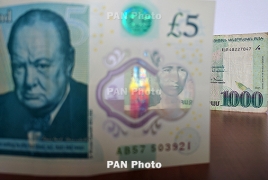 What will new Armenian money look like?Hybrid banknotes By the decision of Central Bank of Armenia (CBA), new hybrid currency will be introduced in the country. To learn some details, PanARMENIAN.Net talked to CBA numismatist Gevorg Mughalyan, who told about the advantages of the new money and explained why it will not be worn out in a short period of time. PanARMENIAN.Net - Traditionally, paper is used a basis for making banknotes, and the money produced by the Central Bank of Armenia is not an exception. However, this kind of money easily gets damaged, worn out and torn. During the past three decades, researches have been carried out to create a raw material for the production of banknotes that could prolong their usage time. As a result, two types of stuff – polymer and hybrid – have been developed to help keep the currency clean and resistant to folding and tearing. Polymer (plastic) money The issuance of banknotes made of polymeric material, or to put it simply ‘plastic money’, will cost twice as much as the paper money, however their usage period will be 2,5-4 times longer. The production of polymer banknotes launched in Austria in 1998. Presently, 28 countries, including Canada, Romania, New Zealand, UK and others, issue this kind of money. Besides the expensive process of production of polymer banknotes, it’s also costly to acquire the devices that count, sort and eliminate them, as well as to reprogram and reequip the ATMs. Hybrid money The hybrid money is printed with part cotton based paper and part polymer. It consists of three layers and comes in two types. The first type is where the inner layer is made of paper, while the outer layers are polymer. For the second type of banknotes, polymer is used for the inner layer, while the two outer layers are made of paper. Modern polymer banknotes were first developed by the Reserve Bank of Australia (RBA), Commonwealth Scientific and Industrial Research Organization (CSIRO) and The University of Melbourne. They were first issued as currency in Australia during 1988. Australia switched completely to polymer banknotes in 1996. Among the other countries that have converted completely to polymer banknotes are: Brunei, Canada, New Zealand, Papua New Guinea, Romania, Kuwait and Vietnam. The latest countries to introduce polymer banknotes into circulation include: the United Kingdom, Cape Verde, Chile, Gambia, Nicaragua, Trinidad and Tobago, Republic of Maldives, Israel and Nepal. Great Britain’s new polymer banknote: endurable and waterproof New Armenian money In the new Armenian hybrid banknotes, the inner layer made of paper will be packed in polymer. The CBA decision was conditioned by a number of reasons. First, the hybrid money will serve much longer that paper banknotes. Whilst polymer banknotes technology is still proven to be the better option, Hybrid banknotes are more economical to manufacture, but not as cheap as those traditionally cotton based banknotes (40% more expensive). Second, the hybrid banknotes will have the security attributes which have already become familiar for the population: watermarks and embedded threads, which is impossible in case of purely polymer notes. As for palpability, hybrid money will resemble the usual paper banknotes, what will help gain people’s trust towards the new currency. Besides, the devices used to count and sort money in Armenia can recognize and accept hybrid money. It means that no additional investments will be needed and hybrid banknotes can be put into circulation along with the paper notes. Kristine Kyurklyan / PanARMENIAN.Net Armenia’s “useless” manpower Small and medium sized businesses weigh in on consequences of war New markets opening for home-grown products An ultimate guide Reduction of personnel and tax collection growth Countries and goods that boosted Armenian export in 2016 8 most important economic events of 2016 |